|
By Ted - 15 Years Ago
|
|
The exhaust testing results were published in the Nov-Dec 2020 issue of The Y-Block Magazine. There were some additional tests in that article that were not published in this particular thread. Because this thread was quite old, the pictures of the various exhausts did not transfer when the website changed servers. The article as it was published in the YBM has been made available on the Eaton Balancing website. Here’s the link. Y-Block Exhaust Testing
Have now completed running an assortment of headers and exhaust systems on the 312 dyno mule. The mule engine is the same +060 over 312 that’s been used in a variety of other tests. Specifics for this engine are cast pistons being 0.025” in the hole, ECZ rods, a Crower Monarch camshaft with 238° dur @ 0.050” and 0.459” lift at the valve after lash, an unmodified Mummert intake, and 750cfm Holley on top of a 2” carb spacer. A set of mildly ported G heads that have been heavily milled brings the compression ratio to 9.6:1 . Originally being unposted G heads, a pair of posts were installed into each head prior to using them for this series of tests. With the mill and the porting, these heads were roughly worth 18HP over a set of stock G heads that had a measured static compression ratio of 9.2:1. With the mild port job, consider these heads a Stage I port job. There’s over 300 dyno pulls now on the mule engine and the bottom end is still holding up fine other than the rear main has started leaking. Although the oil from the rear seal is not pouring out, it’s enough to remind you that this engine is now marking its territory.
Mufflers were tested on most of the exhaust combinations and only with the EMC headers did the HP & TQ numbers actually improve with the addition of mufflers. All other systems did not particularly like the mufflers. Different inlet sized chambered mufflers were used and which ones being used was determined by the exhaust sizing going into them. The test range for this series of tests was 2300 to 5500 rpms. The test range was lowered down to 2300 rpms for the exhaust system testing to get the engine rpms down to that critical lower rpm range that would be seen on a daily driver. Many of the exhaust systems were tested with varying extension pipe lengths and with & without mufflers. For simplicity while also providing a quick overview of how each system performed, here’s the charted summary based on the best score for each system that was tested. Scoring is calculated by adding the average torque and horsepower for the test range, multiplying by 1000 and dividing by the cubic inch. I’ll add that the best score didn’t necessarily give the best peak HP or TQ values but scoring does gives a better indication of how the ‘as tested’ exhaust system will work in regards to overall performance. On this chart, the peak HP and peak TQ values are those that belong with the score while the ‘Testing configs” column tells how many variants of that particular exhaust system were actually tested.
Description. | Score | Peak HP | Peak TQ | Avg HP | Avg TQ | Mufflers | Testing configs | Single exhaust with crossover pipe | 1484 | 239 | 303 | 202 | 276 | NO | 2 | 1955/56 Dual Exhaust manifolds | 1629 | 274 | 327 | 223 | 301 | NO | 4 | Reds two tube headers | 1635 | 278 | 327 | 224 | 302 | NO | 3 | 1957 Dual Exhaust manifolds | 1650 | 279 | 330 | 226 | 305 | NO | 4 | Fenton cast iron manifolds | 1663 | 282 | 332 | 228 | 308 | NO | 2 | Tri-Y stepped shorty Tbird headers non-firing order specific - GB | 1675 | 294 | 332 | 230 | 309 | NO | 4 | Ram Horns w/2” into 2¼” pipes | 1683 | 283 | 337 | 230 | 312 | NO | 2 | Shorty 1.625” w/box collectors - DC | 1693 | 284 | 336 | 231 | 314 | NO | 1 | Sanderson 1½” T-Bird header w/2” pipes | 1724 | 290 | 346 | 236 | 319 | NO | 4 | Sanderson 1½” T-Bird header w/2¼” pipes | 1726 | 289 | 346 | 236 | 320 | NO | 4 | JC 4 tube car chassis shorty headers | 1739 | 296 | 347 | 238 | 322 | NO | 6 | Tri-Y pickup headers firing order specific-CC | 1739 | 297 | 347 | 238 | 322 | NO | 5 | Sanderson 1½” T-Bird header w/2½” pipes | 1751 | 297 | 350 | 240 | 324 | NO | 3 | Sanderson 1½” Pickup headers w/2½” pipes | 1751 | 300 | 350 | 240 | 324 | NO | 5 | Fenderwell headers 1.75” tubes - MW | 1768 | 306 | 344 | 242 | 327 | NO | 5 | Fenderwell headers 1.625” tubes | 1769 | 308 | 346 | 243 | 327 | NO | 5 | KC 4 tube Maxton Mile 1 5/8” headers | 1775 | 310 | 351 | 244 | 328 | NO | 4 | EMC headers 1.75”/1.875” stepped | 1780 | 310 | 349 | 244 | 329 | YES | 4 |
Unfortunately the individual numbers don’t tell the whole story. The torque curves could be manipulated with different lengths of exhaust pipes or the point in which the muffers were inserted into the system. I’ll work on some graphs down the road which will better illustrate this. A big Thank You to all of you that contributed parts or pieces for this exhaust test. For those of you that sent manifolds or headers for testing, email me and let’s work on getting those pieces back to you. My email address is under contact info at the following site: www.eatonbalancing.com
|
|
By YellowWing - 15 Years Ago
|
|
Very interesting Ted. Thank you so much for all your hard work.
|
|
By charliemccraney - 15 Years Ago
|
The greatest improvement comes by simply fitting dual exhaust. That switch alone accounts for nearly half of the total power improvement in the table.
1 1/2" headers are not nearly as bad as I had thought but it does look like 1 5/8" might be generally the best for street performance.
Excellent work, Ted!
At 10.6:1, is it still on pump gas?
|
|
By crenwelge - 15 Years Ago
|
|
It's good to see 50 years later that 1958 dual manifolds were an improvement on my 56 Ford over the stock single. Not just in my head. And besides that it sounded a heluva lot better. And I kinda think the girls were impressed by the 2 chrome tips hanging under the bumper
|
|
By Daniel Jessup - 15 Years Ago
|
|
Ted - we owe a lot to you on having all this information at our fingertips. Talk about dispelling myths, etc. How many of you guys vote for Ted being the next author of a "Y block book"? Obviously, one geared towards performance. In my opinion its about time for another one to hit the mainstream, dispell the myths, tell the real story, and give all of the performance features of the mightY engine we love. 
|
|
By 46yblock - 15 Years Ago
|
|
"The 21st Century Y-block" by Ted Eaton. Sounds Good!
|
|
By MoonShadow - 15 Years Ago
|
|
Ted, Is one of these the headers I sent home with you last year? I think they were pickup style. You had once said you thought they would flow very well. Also how is my project going? Chuck in NH
|
|
By MS 57 Blackbird - 15 Years Ago
|
|
Ted, I would like to concur with the rest of the guys that we are so lucky that we have you doing all the testing for us and I can tell you it has been very beneficial to me and many of us Y-Blockers. I saw a post a while back that Alan Frakes had made indicating that he might be sending you a set of the Bird headers that J. Mummert handles. David Church has a set he will run on his E-Bird that he is restoring and I have a set that will be on my Bird if we can ever get through with the restoration. Thanks to You Again for all your work.
|
|
By bird55 - 15 Years Ago
|
Larry, I was never able to send the FPT tbird headers as I was busy driving the car!
Ted, thanks for all your hard work this is great reference and like Charlie said what a interesting thing to see what happens when you lose the crossover pipe and step up to duals!
|
|
By Pete 55Tbird - 15 Years Ago
|
|
I would like to thank you for another great job of finding and presenting the facts of the Ford Yblock. Mr. Eaton you have done another outstanding job and I am impressed and grateful for all of your hard work. Pete
|
|
By Ted - 15 Years Ago
|
|
Guys. Thanks for the accolades. Much appreciated. As far as a book goes, I’m lucky to just find the time to write the regular articles for the Y-Block Magazine much less sit down and write a book.
MoonShadow (2/12/2011)
Ted, Is one of these the headers I sent home with you last year? I think they were pickup style. You had once said you thought they would flow very well. Also how is my project going? Chuck in NHChuck. The chrome pickup headers you sent back with me are labeled as “Tri-Y pickup headers firing order specific-CC” on the chart. They actually performed quite well. As far as your engine goes, the 471 heads are ported and are currently getting the finished valve work done to them. Still debating on which way to go on the valve springs but that will come to me when the time comes. Block work is finished. The short block just needs the crankshaft balanced and it will then be ready to assemble.
Larry. The headers in the test labeled as “Shorty 1.625” w/box collectors – DC” are those that David and Robin loaned me when I visited y’all last year. They were actually the best sounding of the lot and made a considerable amount of noise when the load was applied to the engine. The difference in sound was quite noticeable from the moment the engine was started with them on it. Something about those square collectors just made an exhaust note that was much different from the rest of the headers that were tested.
|
|
By Ted - 15 Years Ago
|
|
Here’s my favorite picture of the engine taken during the exhaust testing. It’s of the engine with the single exhaust using the crossover pipe on the dyno. I get a funny feeling that one of these crossover pipes hasn’t been on a dyno since Ford did it’s preliminary testing back in the very early Fifties. Burned arms anyone? 
|
|
By Y block Billy - 15 Years Ago
|
|
Ted, Thanks a bunch for all the great work!!! We all owe you!!
|
|
By Richard - 15 Years Ago
|
First and foremost thank you for the testing, I was impressed with the level of detail in the chart and the explanation of the testing.
Are the JC 4 tube headers available? Seems like we don't have a lot out there commercially to choose from in a passenger car.
Thanks again,
Richard
|
|
By Ted - 15 Years Ago
|
|
Richard (2/13/2011)
Are the JC 4 tube headers available? Seems like we don't have a lot out there commercially to choose from in a passenger car. The JC headers are built by Jerry Christenson. You’ll have to give him a call and check on the availability. His phone number as well as some of the header information is listed at the following link. http://www.y-blocksforever.com/yestertech.html
|
|
By Grizzly - 15 Years Ago
|
|
Ted, Firstly I'd like to follow on with kind comments that other members have. I realize that your time is worth money and that any time that you spend on projects like this could be spent on your own projects or personal life. I don't think that I have seen a more comprehensibly tested engine with information on so many components. Thanks for a great effort. Please could we have more information on what the individual headers are and if they are available commercially? Regards Warren Adams
|
|
By yalincoln - 15 Years Ago
|
|
i see that the ram horns would make good street exhaust on a pick-up. excellant work ted, thank you.
|
|
By John Mummert - 15 Years Ago
|
|
Wow! That's a lot of work and a lot of great information. Thank you Ted! Did you paint the ported iron heads silver or are you testing a cross-over system with aluminum heads? I am surprised to see good results with 1-1/2" headers. When I tried some we got pretty poor results. I admit I didn't try different extension pipes. I don't want to say too much just yet but there are some passenger car headers in the works. I don't know how long they will take or even what the final configuration will be. The builder is a name you will recognize if they come to the market. I can only hope that he stays after the project and the results are worth the wait. Thanks to Paul for the loan of the clutch linkage to help things along.
|
|
By 569104 - 15 Years Ago
|
|
Another big thank you! That is a lot of work and a lot of great information!
|
|
By Ted - 15 Years Ago
|
John Mummert (2/14/2011)
Did you paint the ported iron heads silver or are you testing a cross-over system with aluminum heads?  I am surprised to see good results with 1-1/2" headers. When I tried some we got pretty poor results. I admit I didn't try different extension pipes. The heads being used for the exhaust test are just glass beaded with some clear over them to keep them from rusting. Several sets of heads were tested prior to the exhaust test and each set was colored differently to help differentiate them during the test. There will be more on the head tests in an upcoming article for the Y-Block Magazine. Extension pipes made considerable difference on some of the systems. Although I had messed with extensions on the drag cars in the past, I started working more extensively with them on the dyno with the EMC project. With this exhaust test, I simply took those learnings and tried to apply them to a variety of the systems that were being tested. A good example was the Maxton Mile headers. They were way down on power when tested straight out of the collectors with no extensions but with 32” and 40” of 3” diameter extension, the power levels jumped straight up to the top. As became evident during the course of this test, exhaust tuning is too often overlooked. I don't want to say too much just yet but there are some passenger car headers in the works. I don't know how long they will take or even what the final configuration will be. The builder is a name you will recognize if they come to the market. I can only hope that he stays after the project and the results are worth the wait.
Currently working on getting the pictures of the various headers that were tested posted to the site. The USB ports on the computer where the pictures are located have gone dead so I’ve got to get the pictures moved around before I can post them. Looks to be a mother board issue but with Jim’s help, I should have that resolved before long.
|
|
By Ted - 15 Years Ago
|
|
Here are some pics of the various exhaust manfolds and headers that were used in the test. I’ve posted them in the same order as they are on the chart. The exception to this are the Sanderson Thunderbird headers which are only pictured once but were tested with several sizes of exhaust pipes. The Sanderson headers for both the pickups and the Thunderbirds are still available to the best of my knowledge. The Sanderson TBird headers that Mark loaned to me for the test were brand new and never used. Thanks again Mark for letting me break them in for you; those headers shipped back out Monday to you.  Single exhaust with crossover pipe Single exhaust with crossover pipe
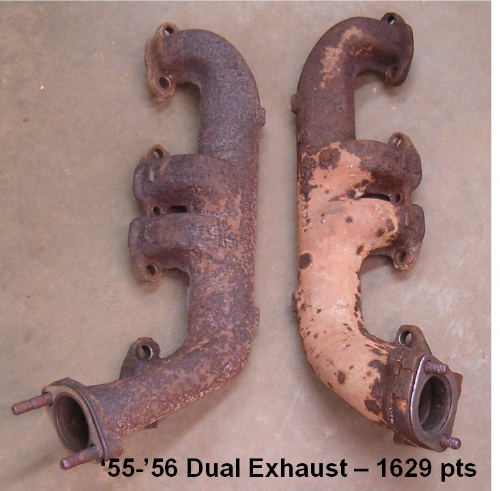 1955/56 Dual Exhaust manifolds 1955/56 Dual Exhaust manifolds
 Reds two tube headers Reds two tube headers
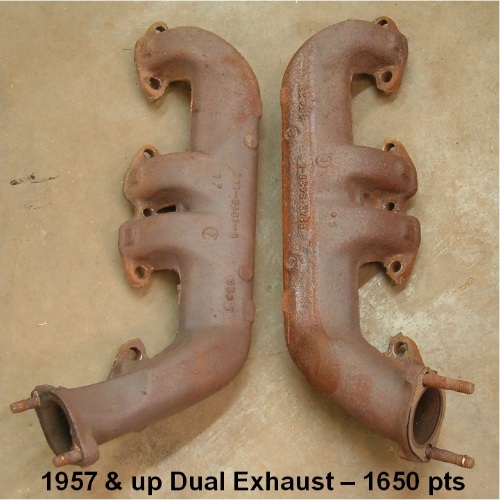 1957 Dual Exhaust manifolds 1957 Dual Exhaust manifolds
|
|
By Ted - 15 Years Ago
|
|
More pics  Fenton cast iron manifolds Fenton cast iron manifolds
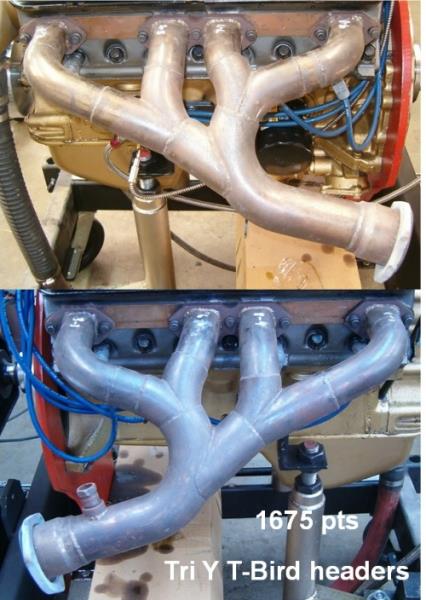 Tri-Y stepped shorty Tbird headers non-firing order specific – GB Tri-Y stepped shorty Tbird headers non-firing order specific – GB
 Ram Horns w/2”into 2¼” pipes Ram Horns w/2”into 2¼” pipes
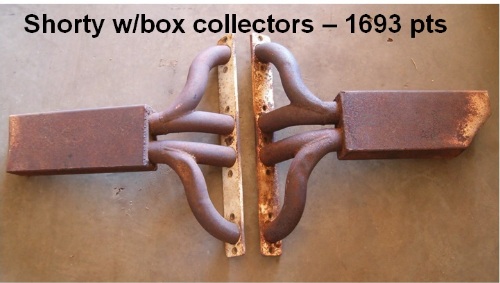 Shorty 1.625” w/box collectors - DC Shorty 1.625” w/box collectors - DC
|
|
By Ted - 15 Years Ago
|
|
More pics  Sanderson 1½” T-Bird headers Sanderson 1½” T-Bird headers
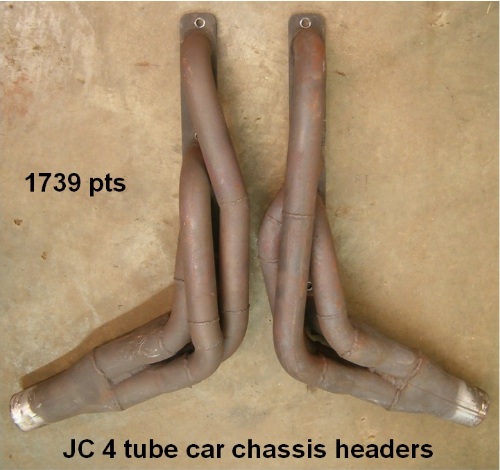 JC 4 tube car chassis shorty headers JC 4 tube car chassis shorty headers
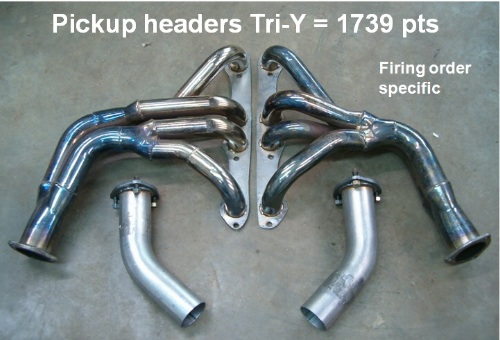 Tri-Y pickup headers firing order specific-CC Tri-Y pickup headers firing order specific-CC
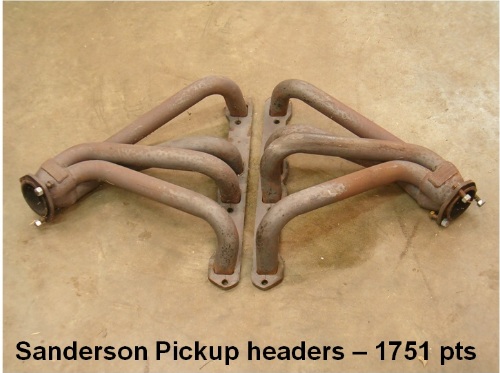 Sanderson 1½” Pickup headers Sanderson 1½” Pickup headers
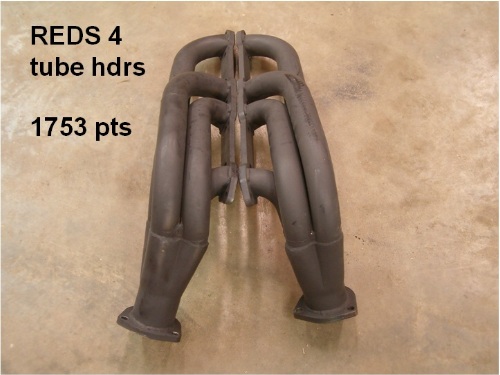 Reds four tube headers Reds four tube headers
|
|
By Ted - 15 Years Ago
|
|
More pics  Fenderwell headers 1.75” tubes - MW Fenderwell headers 1.75” tubes - MW 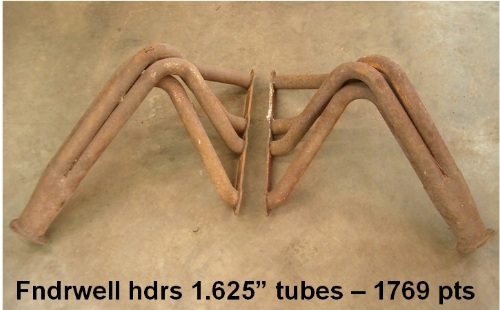 Fenderwell headers 1.625” tubes Fenderwell headers 1.625” tubes 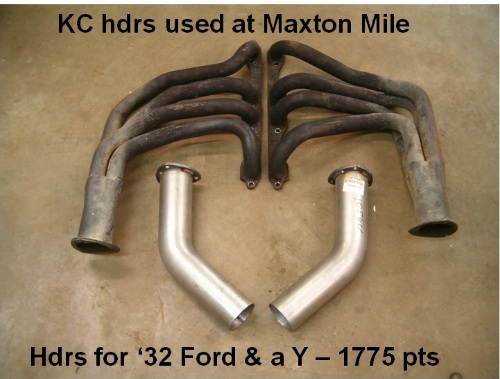 KC 4 tube Maxton Mile 1 5/8” headers KC 4 tube Maxton Mile 1 5/8” headers 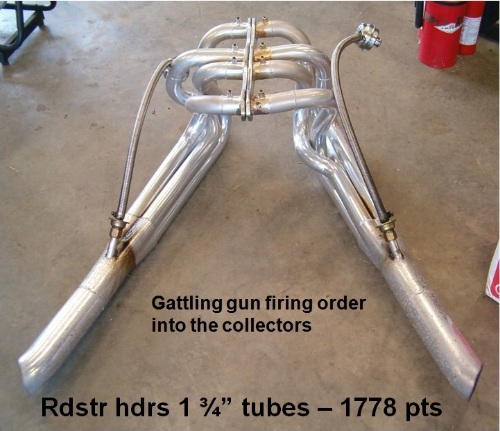 EMC headers 1.75”/1.875” stepped EMC headers 1.75”/1.875” stepped
 Jardine small tube headers Jardine small tube headers
 Unequal length 'by design' tubes Unequal length 'by design' tubes
 Jon Kaase EMC headers Jon Kaase EMC headers
|
|
By pegleg - 15 Years Ago
|
|
Good grief Ted! You must be exhausted!! It's very interesting to see what actually works and what turns out to be "old Wives tales." Red's headers look like a copy of my Hedmans, and everbody said they didn't work. Guess everbody knew what he was talking about.......for this time, anyway.
|
|
By glrbird - 15 Years Ago
|
|
Ted Sanderson should send you some R & D money. I would never have thought the torque numbers on the t-bird headers would be that high. I would never considered them if not for your dyno numbers. Did you try any extensions on them to see if the torque picked up any? Thanks for your dedication to the Y-block, it takes alot of guessing out of what works.
|
|
By Pete 55Tbird - 15 Years Ago
|
|
Ted, If your not too tired of answering foolish questions then I have one more. I have always heard that try-Ys produced more torque at lower RPM than conventional Hedders. And therefore were better for street driving in a car with an automatic. Did your test show this to be a fact or just another urban myth. Enquiring minds want to know. Thanks Pete
|
|
By Ted - 15 Years Ago
|
|
glrbird (2/17/2011)
..... I would never have thought the torque numbers on the t-bird headers would be that high. ...... Did you try any extensions on them to see if the torque picked up any?Gary. The listed score on the chart represents the best score of the various configurations for a particular exhaust system that was tested. In the case of the Sanderson Thunderbird headers there were eleven different configurations tested. Four with 2” dia exhaust pipes, four with 2¼“ dia exhaust pipes, and three configurations tested with 2½“ exhaust pipes. In this particular exhaust test the Sanderson Thunderbird headers were not run directly out of the end of the header collectors simply because that scenario would not be seen in the real world. Because of the testing with the three different diameter lead pipes, the Sanderson TBird headers are listed as three separate categories on the chart. This allowed the best score for each size of pipe to be displayed. Going back through the data, here’s a chart showing the torque curves for the Sanderson headers with 2¼“ lead pipes of varying lengths. You just gotta love graphs as they give a very good overview visually that just cannot be achieved when using charts but by the same token, the graphs can get very busy quickly.
|
|
By Ted - 15 Years Ago
|
|
Pete 55Tbird (2/18/2011)
..... I have always heard that try-Ys produced more torque at lower RPM than conventional Hedders. And therefore were better for street driving in a car with an automatic. Did your test show this to be a fact or just another urban myth.Pete. Here’s the graph showing the torque curves for the firing order specific Tri-Y headers as tested in some of the various configurations. Although I didn’t overlay the graphs, you can look at the previous graph and see where the Sanderson Thunderbird headers start out at a higher torque value at the lowend of the test range than the TriY headers. I had tested the Tri-Y’s in the past without any collectors or exhaust and they were down significantly on peak torque numbers but playing with different length pipes behind any of the systems tested changed up the torque curves quite a bit. The TriY headers with the right length pipes did okay but I wouldn’t say they were leaps and bounds better than anything else tested. Score wise, they were still slightly less than both the Sanderson Thunderbird and Sanderson pickup headers with all else being equal.
Here’s a link to a previous test where the TriY headers were tested without pipes or mufflers and compared to the Reds Headers and the EMC headers on another engine. http://forums.y-blocksforever.com/Topic51444-3-1.aspx
|
|
By charliemccraney - 15 Years Ago
|
|
From what I've read, I don't think tri-y's are exactly a myth, but they also aren't exactly a truth. What it boils down to is if the person designing and building them knows what he is doing, they will provide the desired result... but the same can be said of 4 into 1s. Either way you go, with the proper design, it can outshine everything else on the market.
|
|
By glrbird - 15 Years Ago
|
|
Ted Thanks for the information, This is the best real world info that I have read about header design. Theory on paper and actual number sometimes are far apart. Thanks for taking the time to establish easy to understand data. And yes graphs are wonderful!
|
|
By pegleg - 15 Years Ago
|
|
Interesting how much the longer collecters (?) filled in the the lower end torque numbers. BIG difference there. Almost unnoticeable on the top end.
|
|
By Pete 55Tbird - 15 Years Ago
|
|
Ted If you don`t mind another question regarding your recent exhaust test. From looking at your results it seems to me that for a street driven car or in my case Tbird,that if I need to run mufflers and an exhaust system that includes no more than 2 1/2 inch pipes there is not a lot to be gained from hedders over a 57 factory dual system with mandrel bent pipes of a good size and low restriction mufflers. I can see that this leaves a lot of untapped horsepower at higher RPM but the cost/benefit ratio and noise considerations and the RPM that a street driven car use should be considered. I would welcome any and all thoughts and comments regarding this. Thanks again for your excellent work and giving us so much useful data. Pete
|
|
By pegleg - 15 Years Ago
|
|
Pete, the Red car in my avitar does just that. Manifolds and a 2 1/2 inch exhaust system. It's gone a 13.50 @106 mph. Does not seem like there's much to be gained below 3000, 3200 rpm. After that the headers win.....big time
|
|
By Ted - 15 Years Ago
|
|
Pete. Here’s torque and horsepower graphs comparing the ‘57 exhaust manifolds against the Sanderson Thunderbird headers as tested with mufflers. Just looking at the torque graph shows a favorable torque increase with the headers at cruising rpms versus using the ’57 exhaust manifolds. Once the engine hits its power band in the mid 3000 rpm range, the headers just take off and run away from the factory exhaust manifolds. 

|
|
By yalincoln - 15 Years Ago
|
|
say ted, could you show the ram horns in those two graphs, for the pick-up guys, thanks, wayne.
|
|
By Ted - 15 Years Ago
|
|
Wayne. Lots of data here so I'll use exhaust testing that's specifically applicable to the pickup crowd. Here are a pair of graphs that compares the Sanderson pickup headers to the Rams Horns manifolds. All the curves on these graphs are with the mufflers in place. 

|
|
By yalincoln - 15 Years Ago
|
|
thanks ted, i copyed the graphs and i can over lap them. excellent work.
|
|
By BIGREDTODD - 15 Years Ago
|
|
Ted, Can't thank you enough for the great presentation of data, and the thorough exploration of configurations. Your data confirmed what (I hoped) was the besto option for me, and gave me the information to confidently go through with ordering a set of Sanderson (coated) T-Bird headers. 
Headers are a (relatively) significant investment, and your testing took virtually all of the guess-work out of it for me.
|
|
By charliemccraney - 15 Years Ago
|
Todd,
One set that wasn't tested but may be worth considering is the pickup long tubes from Speedway. They're 1 5/8, and appear to be mandrel bent but I have not called about them. The you weld it kit is about $160.00 so there is room to make it work with your application and stay under budget. Looking at the tests, I think it looks like 1 5/8" really are a great starting point, and considering the power you will be making, it may be beneficial to go a little bigger.
|
|
By Ted - 15 Years Ago
|
|
Todd. Your headers look really good coated. The set I was using for the tests were not yet coated and there’s some horsepower to be found in the coatings as well as a reduction in the underhood temperatures when those coatings are applied both internally and externally. Be forewarned that those ceramic coatings do not like being superheated as happens when the car is simply sitting at an idle for extended periods of time. Any kind of air movement under the hood will allow the coating to remain shiny much longer but any overheating of them will dull the finish. Whenever I run coated headers on the dyno, I have fans sweeping air across them to preserve the shine.
|
|
By BIGREDTODD - 15 Years Ago
|
|
Charlie, While you probably have valid points from a pure power standpoint, there were a few key items that influenced my decision. I'm all but certain that the 312 in my 'Bird (upgraded with cam, big valves, intake, etc.) is by no means as stout as Ted's test engine. With 2" or 2 1/4" exhaust, and the FOM transmission, the max HP and upper end is not nearly as important as torque. The cosmetic factor is also huge, given the amount of effort put into the under hood appearance. With the coating, (agree 100% with Ted's comments above) I believe the appearance and performance characteristics will be the best overall choice. And Ted, that's just a Sanderson picture...mine haven't arrived yet. Probably next week. Once I finish everything on the LSR Uni' I'll be doing an ignition upgrage on the Caddy in my '60, then doing the (hopefully) final assembly under the hood on the 'Bird to get her going by the time fair weather arrives. That is, if we (in CA) make it through the laughably apocalyptic snow dusting that the weather folks are predicting over the next couple of days
|
|
By charliemccraney - 15 Years Ago
|
|
Oooooohhhhh, they're for the 'bird. I was thinking you were going to use them for the unibody. Nevermind.
|
|
By BIGREDTODD - 15 Years Ago
|
|
charliemccraney (2/24/2011)
Oooooohhhhh, they're for the 'bird. I was thinking you were going to use them for the unibody. Nevermind....yeah, for the Uni', and what you said above is actually the path being taken, just not by me. I believe the cage guy is attacking that, but that's another thread
|
|
By Ted - 15 Years Ago
|
|
yalincoln (2/22/2011)
say ted, could you show the ram horns in those two graphs, for the pick-up guys, thanks, wayne.Wayne. Took me a bit to figure out that you wanted to compare the ’57 exhaust manifolds to the Ram Horns? If that’s the case, then here are the graphs for that comparison with and without mufflers.

|
|
By speedpro56 - 15 Years Ago
|
|
Another thing when I talked to Jay at Sanderson he said once they have a pattern they can do different sizing on the runners as going from 1 1/2" to 1 3/4" etc in some cases.
|
|
By yalincoln - 15 Years Ago
|
|
thanks ted. i love those graghs. what dia. is the outlet in each manifold. and what length pipes are you using. 56"?
|
|
By ScottY - 15 Years Ago
|
|
G'Day Ted, And guys, I follow this site a lot , even though i rarely respond, (guess that's obvious), As with everyone, a thank you for your time and efforts, and if i may, I have a question that i've not seen, heard of, read or been able to have answered. (that's not to say it isn't out there) But why are the header flanges shaped as per port design/shape, when round pipe is used? (obviously) That is to say, why not just round flanges for round pipe? When as often as not, the pipe is somewhat "re-shaped" to fit the flange anyway. This of course is irrespective of engine make. I can only assume that there is a very good reason for it, and although i do have a theory or two of my own, i'm unable to see it/them as viable all the same. My main reasoning is along the lines of the effect on the airflow, transitioning from port to pipe. Thanks for your thoughts and congrats on the EMC effort, "Outstanding"! I welcome any and all responses.
|
|
By mctim64 - 15 Years Ago
|
Great stuff Ted! I've been fallowing it from the start, I just wish I could send you the custom set that will be made for the "Uni" it would be interesting to see how they do. Maybe in the winter next year if you have the "Mule" up and ready. 
|
|
By charliemccraney - 15 Years Ago
|
|
Tim, What about the set that was made for Charlie but didn't fit?
|
|
By mctim64 - 15 Years Ago
|
|
charliemccraney (2/26/2011)
Tim, What about the set that was made for Charlie but didn't fit?I bought a new kit but we will be using the flanges and some of the tubes from those, nothing goes to waste.  I might add that they are a lot like Teds EMC headers so I would think performance would be close. The new ones will have some interesting bends to get around the steering box and even the pass. side will have to be close to the same to even things out.
|
|
By Oldmics - 15 Years Ago
|
Scotty (2/26/2011)
G'Day Ted, And guys, I follow this site a lot , even though i rarely respond, (guess that's obvious), As with everyone, a thank you for your time and efforts, and if i may, I have a question that i've not seen, heard of, read or been able to have answered. (that's not to say it isn't out there) But why are the header flanges shaped as per port design/shape, when round pipe is used? (obviously) That is to say, why not just round flanges for round pipe? When as often as not, the pipe is somewhat "re-shaped" to fit the flange anyway. This of course is irrespective of engine make. I can only assume that there is a very good reason for it, and although i do have a theory or two of my own, i'm unable to see it/them as viable all the same. My main reasoning is along the lines of the effect on the airflow, transitioning from port to pipe. Thanks for your thoughts and congrats on the EMC effort, "Outstanding"! I welcome any and all responses. Scotty From the book entitled Scientific Design of Exhaust and Intake Systems-Philip H.Smith and John C.Morrison "It may be considered that the slightly increased area at this point is of benefit in reducing pressure,particularly as there is often a sharp bend in the cast manifold bolted thereto." Its due to the bends encountered being so close to the flange. I also remember reading something on exhaust by Bill Jenkens. It stated that since there is a high pressure charge being released thru the opening of the exhaust valve that there was turbulance in the flow.This resulted in possible contamination of the incoming charge due to the camshaft overlap sucking the spent charge back into the cylinder. Basically the spent charge would creep up the outer edges inside the pipe.By keeping the flange at a greater opening than the pipe diameter the spent charge has a more difficult time getting back thru the exhaust valve.The spent charge is blocked by the actual head material exposed by the flange opening. Oldmics
|
|
By pegleg - 15 Years Ago
|
|
Along with Phillip Smith who did some incredible studies in the 50's and 60's, the There were a number of others. Oldsmobile (yeah I know, GM) did very extensive studies in the late 60's, so did Chrysler (remember the long rams on the 413's?) They usually came to the conclusion that the area on the INSIDE of a bend is wasted. Might as well close it off to keep the flow laminer as long as possible. The other issue being that the smaller cross section will keep flow velocities up at lower RPM, while not really affecting the higher RPM flow.
|
|
By Ted - 15 Years Ago
|
|
Scotty (2/26/2011)
.......I have a question that i've not seen, heard of, read or been able to have answered. (that's not to say it isn't out there) But
why are the header flanges shaped as per port design/shape, when round pipe is used? (obviously) That is to say, why not just round flanges for round pipe?[/b] When as often as not, the pipe is somewhat "re-shaped" to fit the flange anyway. This of course is irrespective of engine make. I can only assume that there is a very good reason for it, and although i do have a theory or two of my own, i'm unable to see it/them as viable all the same. My main reasoning is along the lines of the effect on the airflow, transitioning from port to pipe.Old Mics has pretty touched on many of the points regarding why the ports in the headers or the manifolds are shaped like they are. I’ll add that if the heads are ported to the common rectangular shape, then a round port at the header flange can be obstructing part of the exhaust flow into the header. A rectangular port at the header will allow for the same cross-sectional surface area as a round port but will be a much better fit to the port at the head. On the stock exhaust ports at the heads, most are small enough that a round header port at the flange will not present any kind of obstruction so round ports can be found on the flanges of some of the older Y-Block header offerings simply due to the ease of manufacturing them. As far as the use of round tubing for headers goes, that’s what is readily available. Square tubing actually looks to have a flow advantage but is difficult for the average shop to perform the necessary mandrel bends to keep that flow advantage to the forefront. Hence, 99.9% of the headers you see use round tubing. . The ported aluminum heads on the EMC project engine have a very rectangular or oblong exhaust port which fits up to a very similar shaped exhaust port on the headers. Flow restrictions at the header to head are thus minimized. General header design typically points to having an exhaust port at the header that’s slightly larger than the port at the head so that reversion pulses coming back up the header tube hits the head rather than going back into the cylinder. As the overlap cycle in a camshaft is increased, also is the propensity for some of the exhaust to be pulled back into the cylinder during that cycle. By maintaining a larger header port size than the port size at the exhaust exit at the head, some of the potential for dilution of the fresh intake charge going into the cylinder is minimized. . Here’s a link to a past thread showing some different exhaust porting techniques which in turn requires appropriate header ports or flanges to match. http://forums.y-blocksforever.com/Topic46226-3-2.aspx
|
|
By Ted - 15 Years Ago
|
|
yalincoln (2/25/2011)
thanks ted. i love those graghs. what dia. is the outlet in each manifold. and what length pipes are you using. 56"?Wayne. Both the 1957 dual exhaust and Rams Horn manifolds have a 2” exhaust opening at the exits. For the graph curves that are displayed and for the ’57 manifolds, the exhaust pipes were 2” diameter and 80” long with the mufflers added to this; for the ‘no muffler test’ came with the pipes being 32” long which produced the best score for the no muffler test. For the Rams Horn manifolds, the pipes were 2” diameter leaving the exhaust manifolds, then enlarging to 2½” diameter and were 56” long.
|
|
By yalincoln - 15 Years Ago
|
|
thanks ted. i'm wandering if the 57 dauls might not have done better with the 2.5 in pipes. just trying to check apples to apples, HA!HA!
|
|
By idaho211 - 15 Years Ago
|
|
Ted, I appreciate all of the work you did on the different exhaust manifolds. Great results!! A couple of questions on my 60 ford 4x4 which now has single crossover exhaust to stock muffler coming out midway down the truck: 1. Thinking of using ram horn or sanderson truck headers. Would you use 2 and 1/4 on ram horn and 2 and 1/2 pipes on Sanderson truck headers? 2. I need to have some type of noise suppression but would like to have minimal resistance to flow, would you recommend mufflers or something like a glass pack? 3. Also the exhaust comes out mid way down the truck. Would you continue with the route or go full length and exiting out the back? Do you recommend a certain length between manifold and muffler as well as tailpipe length? Appreciate feedback from all
|
|
By aussiebill - 15 Years Ago
|
|
The ported aluminum heads on the EMC project engine have a very rectangular or oblong exhaust port which fits up to a very similar shaped exhaust port on the headers. Flow restrictions at the header to head are thus minimized. General header design typically points to having an exhaust port at the header that’s slightly larger than the port at the head so that reversion pulses coming back up the header tube hits the head rather than going back into the cylinder. As the overlap cycle in a camshaft is increased, also is the propensity for some of the exhaust to be pulled back into the cylinder during that cycle. By maintaining a larger header port size than the port size at the exhaust exit at the head, some of the potential for dilution of the fresh intake charge going into the cylinder is minimized. Here’s a link to a past thread showing some different exhaust porting techniques which in turn requires appropriate header ports or flanges to match. http://forums.y-blocksforever.com/Topic46226-3-2.aspx
Ted, i chuckle and think back as a kid when there was no technology except seat of the pants street tuneing coupled with youthfull exuberence and often ported my exhaust ports to 1 1/2" dia , figuring the ex valve was that dia, it then matched up to pipes good, but if the truth be known by todays testing etc would have made little difference? At least it seemed better? ha,ha.
|
|
By Ted - 15 Years Ago
|
|
yalincoln (2/28/2011)
thanks ted. i'm wandering if the 57 duals might not have done better with the 2.5 in pipes. just trying to check apples to apples, HA!HA! Wayne. Although I only tested the ’57 dual exhaust manifolds with 2” sized pipes, some of the differences between pipe sizes in conjunction with a pipe sized chambered muffer can be applied from the Sanderson Thunderbird header test. There were eleven different exhaust configurations tested with the Sanderson TBird headers so there’s a lot of data available for those particular headers including mufflers with the various sized pipes. I’ll go out on a limb and say that the 2½” pipes on the ’57 exhaust manifolds will still see a significant performance improvement over 2” pipes even though the exhaust outlet at the manifolds is only 2”. I look at the 2” restriction being a built in merge collector. Maybe Frank can add to this as he has the 2½” pipes on his ’57.
idaho211 (2/28/2011)
Ted, A couple of questions on my 60 ford 4x4 which now has single crossover exhaust to stock muffler coming out midway down the truck: 1. Thinking of using ram horn or sanderson truck headers. Would you use 2 and 1/4 on ram horn and 2 and 1/2 pipes on Sanderson truck headers? 2. I need to have some type of noise suppression but would like to have minimal resistance to flow, would you recommend mufflers or something like a glass pack? 3. Also the exhaust comes out mid way down the truck. Would you continue with the route or go full length and exiting out the back? Do you recommend a certain length between manifold and muffler as well as tailpipe length? Appreciate feedback from all Don. The Rams Horn manifolds were only tested with what I’ll call 2½” diameter pipes. The pipe used for the test was necked up from 2” to 2½” at the manifold due to the manifold outlet size. As far as personal preference on mufflers, I prefer quiet and with that in mind, a chambered muffler. And so there's not a drone or roar under the vehicle when cruising, pipes to the back of the vehicle to move the noise as far back as possible.
For the Sanderson TBird header test, three different sized pipes were tested along with the appropriate sized muffers at the end of each pipe. The scoring for each size pipe along with its corresponding muffler is a follows: 1454 pts - 2” pipes with 2” inlet/outlet mufflers 1462 pts - 2¼“ pipes with 2¼“ inlet/outlet mufflers 1488 pts - 2½“ pipes with 2½“ inlet/outlet mufflers Here are the torque and horsepower graphs for the Sanderson T-Bird headers with mufflers and with the various sized pipes. 

|
|
By Ted - 15 Years Ago
|
aussiebill (2/28/2011)
Ted, i chuckle and think back as a kid when there was no technology except seat of the pants street tuneing coupled with youthfull exuberence and often ported my exhaust ports to 1 1/2" dia , figuring the ex valve was that dia, it then matched up to pipes good, but if the truth be known by todays testing etc would have made little difference? At least it seemed better? ha,ha.  Know what you mean. I did the same but by the same token, it was equal footing for all back then. In retrospect, that older stuff still ran good. Most of the testing back then took place in the car and if you were lucky, on a drag strip with timers.
|
|
By pegleg - 15 Years Ago
|
|
Since I've never run the car with less than 2 1/2" pipes my knowledge would be lacking. I went to the 2 1/2's because the rules allowed that size. But the outlets on the manifolds cannot be ported, so they're still roughly 2 1/4". that has to be a restriction. Remember the motor is supercharged, so it needs all the help on the exhast side i can give it.That being said, the engine has been calculated to make 344 hp to the wheels through the mufflers. (2-1/2" flowmasters). It would be interesting to see what a good set of headers would do for it. Mummert and I tried a set or Yestertech headers on the Dyno. they were Roadster Headers, with very long primaries, I picked up 50 foot lbs of torque at 3000-3200, but very little top end horse power. But you can see the potential!
|
|
By yalincoln - 15 Years Ago
|
|
thanks, frank and ted. i think i got what i needed. again i appreciate all your time and work just to help the rest of us out, wayne.
|
|
By idaho211 - 15 Years Ago
|
|
Ted, Thank you for the reply on the Ram horn and muffler recommendation. One thing you mentioned going from 2 inch on the manifold to 2.5 inch pipes. I see on the test it said 2.25. Would you recommend 2.5 or 2.25 pipes from the exhaust manifolds? Appreciate the help.
|
|
By Ted - 15 Years Ago
|
|
idaho211 (3/4/2011)
Ted,........One thing you mentioned going from 2 inch on the manifold to 2.5 inch pipes. I see on the test it said 2.25. Would you recommend 2.5 or 2.25 pipes from the exhaust manifolds? Appreciate the help.Don. The Sanderson headers were tested with 2”, 2¼“, and 2½” pipes but the Rams Horn manifolds were only tested with 2½” pipes. If using the Sanderson header test as a basis for pipe sizing in general, then the 2½” pipes will still work best on the Rams Horn manifolds even if the 2” outlet on the manifolds is maintained. The key here is keeping the 2” to 2½”transition on the exhaust pipe itself as short as possible. But taking this a step further, any enlargement that can be done to the RH manifold outlets will be beneficial so I’d recommend doing some custom work in that area when initially fitting up the pipes. A 2¼” outlet on the RH manifolds would obviously be better and if you could work a 2½” outlet in there, then even better yet. Here are pictures of the exhaust pipe used in the test with the Rams Horn manifolds and a 2” outlet to give you an idea of how the exhaust hookup was made to achieve the 2½” pipe diameter.

|
|
By grovedawg - 15 Years Ago
|
|
All other systems did not particularly like the mufflers. Different inlet sized chambered mufflers were used and which ones being used was determined by the exhaust sizing going into them.
I'm wondering if a muffler with a "straight through" design like a glass pack, or steel pack muffler would piss the Y Block off. I'm planning on running either Porters, or Smithy's. But if "ALL OTHER SYSTEMS DIDN'T PARTICULARLY LIKE MUFFLERS" then I may end up running straight pipes. What are you thoughts all wise one? 
|
|
By Ted - 15 Years Ago
|
grovedawg (3/10/2011)
I'm wondering if a muffler with a "straight through" design like a glass pack, or steel pack muffler would piss the Y Block off. I'm planning on running either Porters, or Smithy's. But if "ALL OTHER SYSTEMS DIDN'T PARTICULARLY LIKE MUFFLERS" then I may end up running straight pipes. What are you thoughts all wise one?  Here's my two cents worth. The only straight thru mufflers used in the extensive exhaust test were the Magnaflow mufflers used with the EMC headers. Those mufflers had 3½” inlets and 3½” outlets which was a perfect match for the outside collector diameter on the EMC headers. On the EMC headers, the Magnaflow mufflers actually improved the score over no muffler at all. Part of this is a result of the muffler sizing actually being larger than the actual downsized opening within the collector itself. I was running a 3" merge collector within the outer 3½" collector. All the other systems when tested with mufflers used a chambered muffler design which were overall quieter but also more restrictive. Based on this, a straight thru muffler would be better from a performance standpoint than a chambered muffler.
|
|
By idaho211 - 15 Years Ago
|
|
Ted, Thanks for the reply about the ram horns and the pics to help explain it. I am on the fence about ram horns or sanderson truck headers. Like the look of the ram horns and clearance on my truck.
|
|
By Ted - 15 Years Ago
|
|
Here’s some more information that adds two more sets of headers to the list of those that have already been tested. These were also tested on the same engine combination as all the other exhaust systems which keeps comparisons equal. Whereas only the best scores for each exhaust system were previously posted regardless of the number of configurations tested, here are the scores for each tested configuration for these two sets of headers. The scores are still based on the overall performance in the 2300-5500 rpm range. As in the previous tests, the mufflers continue to be appropriately sized based on the size of pipe that’s used in each test. In the FPA header test chart below, there were three different pairs of mufflers being used. The Ford Powertrain Applications (FPA) headers were unique in that the best numbers achieved were without any exhaust extensions being used and part of this could be attributed to the merge collector design being used at the ball shaped muffler connection at the end of the headers. Many of the headers being tested did like some form of exhaust extension in which to improve their overall performance. Crossover pipes were also tested and you can make your own assumptions based on the numbers. Sometime in the near future, I’ll post the lower rpm band information which is where the crossover pipes appears to make the most difference when comparing the graphs. FPA T-Bird 4 Tube 1.625”/1.75” stepped headers | Score | Peak HP | Peak TQ | Avg HP | Avg TQ | Mufflers | 2.25” pipes 64” long w/mufflers | 1738 | 298 | 346 | 238 | 322 | Yes | 2.25” pipes 64” long w/ no muffs | 1749 | 298 | 348 | 239 | 324 | No | 2.25” pipes 18” long w/ no muffs | 1761 | 306 | 352 | 242 | 325 | No | | 2.25” pipes 64” long & 2” dia crossover pipes and w/mufflers | 1735 | 300 | 347 | 238 | 321 | Yes | 2.25” pipes 64” long & 2” dia crossover pipes and w/ no muffs | 1757 | 303 | 349 | 241 | 325 | No | 2.25” pipes 18” long & 2” dia crossover pipes and w/ no muffs | 1761 | 304 | 352 | 242 | 325 | No | | 2½” pipes 64” long w/mufflers | 1748 | 297 | 348 | 239 | 323 | Yes | 2½” pipes 64” long w/ no muffs | 1757 | 297 | 349 | 241 | 325 | No | 2½” pipes 18” long w/ no muffs | 1763 | 306 | 354 | 242 | 325 | No | | 3” pipes 64” long w/mufflers | 1748 | 300 | 346 | 240 | 323 | Yes | 3” pipes 64” long w/ no muffs | 1764 | 303 | 349 | 242 | 326 | No | 3” pipes 18” long w/ no muffs | 1774 | 308 | 356 | 244 | 328 | No | | No pipes – open headers | 1780 | 311 | 342 | 244 | 329 | No |
Roadster 1.75” tubes 31” long with 18” long 3” dia collectors & no mufflers | Score | Peak HP | Peak TQ | Avg HP | Avg TQ | Without evacuation system hooked up | 1768 | 307 | 354 | 243 | 327 | With evacuation system hooked up | 1778 | 309 | 355 | 244 | 329 |
|
|
By charliemccraney - 15 Years Ago
|
Since the score continues to increase as the pipe diameter is increased, might some cone shaped expansion chamber help to achieve the higher numbers while still using a pipe and possibly a muffler.
The crossover pipe, is it an H or an X?
How does the open header graph compare to the EMC header graph?
|
|
By Ted - 15 Years Ago
|
|
charliemccraney (3/27/2011)
Since the score continues to increase as the pipe diameter is increased, might some cone shaped expansion chamber help to achieve the higher numbers while still using a pipe and possibly a muffler.
The crossover pipe, is it an H or an X?
How does the open header graph compare to the EMC header graph?Charlie. Even with an expansion chamber, any restriction at the muffler would be seen at the engine and ultimately bring down the power numbers. But once the restriction part is taken care of, an expansion chamber could be used to move the torque curve around. The mufflers being a straight thru design over a chambered design are expected to show up as an advantage in this case. The mufflers on the EMC headers are a straight thru design while all the other mufflers tested were the chambered design. The crossover pipe being used in this particular test is the H design. Here are a couple of pics of the crossover pipe that’s being used.   Here’s the graph comparing the open FPA headers without mufflers to the EMC headers with and without mufflers. Because the horsepower is so similar on both, I’m displaying only the torque values which gives a better resolution. 
|
|
By ScottY - 15 Years Ago
|
|
Thanks all for your comments/replies, the use of round pipe was never in question, it was the point of using a "square" port flange and re-shaping the pipe to suit. Why all the extra effort, when the relevant sized tube for the port would be so much simpler/cleaner. When in dedicated racing use, more often than not, that is exactly what is done. Now I realise horses for courses, which brings me back to the line of thought, that there must be a valid advantage/reason. Sorry if I seem dumb, or sound like a broken record, but could try explaining again. Thanks again, Scotty!
|
|
By Ted - 15 Years Ago
|
|
Scotty (3/30/2011)
Thanks all for your comments/replies, the use of round pipe was never in question, it was the point of using a "square" port flange and re-shaping the pipe to suit. Why all the extra effort, when the relevant sized tube for the port would be so much simpler/cleaner. When in dedicated racing use, more often than not, that is exactly what is done. Now I realise horses for courses, which brings me back to the line of thought, that there must be a valid advantage/reason.Looks like I’m going to do another of those lengthy explanations here. For the most part, if you can put a dollar sign to the question, you’ll find the answer. In this case, it costs much less for the header manufacturer to utilize round ports at the header flange as these are much easier to produce than the ‘square’ ports at the flanges. That’s the dollar sign answer.. But the essence of your question boils down to laminar flow versus turbulent flow at the exhaust port exit. With a round header port matching up to a square exhaust port at the head, there will be more turbulent flow at that point and part of that is due to ‘eddies’ that are being produced at the edges of the port. Those ‘eddies’ come about due to the extreme irregularity of the two different shaped ports being mated up to each other. When both the exhaust port and the header/manifold are similar in shape, then the flow becomes more laminar and as such, overall flow potential is increased simply due to the reduction of eddy currents in the air flow where the header meets the head. . Besides the flow properties of a square or rectangular port on the head going to a similar shaped port on the header being an improvement over that of a round port, space utilization at the exit area on the head with a square or rectangular port is also better. An example is a 1.625” round port will have a square surface area of 2.074 inches. A square port that’s 1.44” X 1.44” will have the same cross-sectional flow area at 2.074”. Although the cross-sectional areas are the same, the non-round shaped port will have a greater flow capability than the perfectly round port. . On the stock heads, round ports at the headers are typically not a serious detriment in regards to flow obstructions or gasket sealing as the corners of the ports on the heads are still within the boundaries of the round port at the header. When increasing the head exhaust port sizes beyond stock, then the outside boundary of the round header port size can be exceeded which makes for a flow inhibiting obstruction for the exhaust to make its way past. At this point, the square ports become a necessity if the ports at the heads retain the overall square configuration. . I’ll also add that the exhaust port gasket sealing area on a rectangular head exhaust port is substantially increased when using a similar shaped header port. Going to a round port on the exhaust manifold or header where the head port exit is rectangular will minimize gasket sealing on the vertical and horizontal centerlines at the edge of the ports. . Here’s a link to the thread showing some various ports and how the gasket sealing area is affected when doing a rectangular versus round port at the head. Obviously with a round port at the head, it’s also going to take a round port at the header as it would be a monster sized square port to compensate for the round port size. http://forums.y-blocksforever.com/Topic46226-3-2.aspx
|
|
By ScottY - 15 Years Ago
|
|
Hi There Again Ted, Thanks very much for your extra time in rehashing my question. that is much appreciated I assure you. Your answer is pretty much along the lines i had in mind also, but couldn't quite rationalise it to myself. so again, thanks. Also, how did those heads ported to round exhausts perform on your tests? I had a bit of a search for it but didn't find it. As Aussie Bill said he had done that back in the day, so to had an Uncle of mine, though not on a Y-Block. Hope all is well with you n yours, and another congrats on the EMC Project, fantastic result! yours Scotty!
|
|
By jardine - 15 Years Ago
|
Ted has hit the nail on the head as to port match. The whole anti reversion theory is simply a band aid for a screwed up header to start with. How much time and money do you spend to blueprint the intake to head? The same should apply to exhaust port. It's even more critical as the exhaust pulses are traveling way faster. This week I'm building a set of headers on a 632ci drag car. The customer supplied the flanges with a 2.5" round port. The port is actually happy with a 2" tube. I spent a lot of time sleaving it down to 2". The collector is 2 3/8". The 2" at the port cones out to 2 1/4".
Thanks,
Jerod.
|
|
By Ted - 15 Years Ago
|
|
ScottY (4/7/2011)
........ Also, how did those heads ported to round exhausts perform on your tests? I had a bit of a search for it but didn't find it. As Aussie Bill said he had done that back in the day, so to had an Uncle of mine, though not on a Y-Block. That particular pair of heads with the round exhaust ports exhibited middle of the road performance gains when tested against other heads with conventional exhaust ports. Here's the graphs showing how that particular set of heads did with three different sets of headers. 
|
|
By ScottY - 15 Years Ago
|
|
Thanks again Ted, Reasonably impressive wouldn't you say Though well up there in rev range, and I would assume to though, that all these headers had the square port flanges still wouldn't they, and if so, surely none would have been large enuff to uncover/restrict, the ports?
|
|
By Ted - 15 Years Ago
|
|
ScottY (4/10/2011)
......I would assume too though, that all these headers had the square port flanges still wouldn't they, and if so, surely none would have been large enuff to uncover/restrict, the ports?The fenderwell headers were the only set of headers of the three sets used in the round port head test that actually had round ports at the header flanges. The round ported heads themselves were actually ported back in their day to match up to this particular set of headers. The EMC and Sanderson headers have rectangular ports that were actually smaller than the ports at the heads and as a result, both sets had some flow obstructions taking place as a result of the mismatch at the heads. But to look at the torque graph, the EMC headers outshined the other two sets of headers in the lower rpm band regardless of the port mismatch. But as usual, there’s much more happening here than just a head to header flange port mismatch. The large dip in torque seen with the fenderwell headers has since been attributed to the collector size on that particular set of headers as being way too large. Had this been recognized at the time of the round port head test, the fenderwell headers would have performed much better with downsized collectors. Since doing that particular cylinder head test, the fenderwell headers have been tested again with a different set of heads on the engine but also with collector extensions that brought the collector sizes down from 4” to 3”. With that change, much of the pronounced dip that was evident with the 4” collectors was removed from the lower rpm band of the curve. Here’s the torque graph where the round ported fenderwell headers were tested on the mildly ported G heads that have rectangular exhaust ports. 
|
|
By pegleg - 15 Years Ago
|
Now THAT'S interesting! the mufflers did just exactly the opposite of what my intuition would have expected. More top end HP (TQ) and lower readings in the midrange. Splain that Lucy.
|
|
By Ted - 15 Years Ago
|
|
Gary R. (site member) had very recently shipped to me the latest Reds header offering for the ‘55/56 car chassis. This new header is a four tube header design feeding into a very short 2½” collector. Overall it’s still a shorty header but fares much better than the older two tube version that was tested. Scoring is still calculated starting at 2300 rpms and ending at 5500 rpms. I’ll add that this is also the best scoring chassis header that is designed to fit into the mid-fifties Ford cars. All the other headers that outscored this particular set are either race car or dyno specific. Here are the detailed results for this particular header. Reds 55/56 car 4 Tube 1.625” headers | Score | Peak HP | Peak TQ | Avg HP | Avg TQ | Mufflers | 2” pipes 68” long w/mufflers | 1690 | 287 | 338 | 231 | 313 | Yes | 2” pipes 66” long w/ no muffs | 1730 | 290 | 344 | 236 | 321 | No | 2” pipes 24” long w/ no muffs | 1726 | 303 | 344 | 237 | 319 | No | | 2½” pipes 75” long w/mufflers | 1729 | 292 | 345 | 237 | 320 | Yes | 2½” pipes 75” long w/ no muffs | 1753 | 295 | 347 | 240 | 325 | No | 2½” pipes 28” long w/ no muffs | 1746 | 307 | 349 | 240 | 322 | No | 2½” pipes 20” long w/ no muffs | 1740 | 309 | 343 | 239 | 321 | No | 2½” pipes 12” long w/ no muffs | 1721 | 304 | 332 | 236 | 318 | No |
And here is the revised chart showing the ‘best’ score for each exhaust system tested thus far. Keep in mind that the best score does not necessarily produce the best peak horsepower or peak torque values. Description. | Score | Peak HP | Peak TQ | Avg HP | Avg TQ | Mufflers | Testing configs | Single exhaust with crossover pipe | 1484 | 239 | 303 | 202 | 276 | NO | 2 | 1955/56 Dual Exhaust manifolds | 1629 | 274 | 327 | 223 | 301 | NO | 4 | Reds/Hedman two tube headers | 1635 | 278 | 327 | 224 | 302 | NO | 3 | 1957 Dual Exhaust manifolds | 1650 | 279 | 330 | 226 | 305 | NO | 4 | Fenton cast iron manifolds | 1663 | 282 | 332 | 228 | 308 | NO | 2 | Tri-Y stepped shorty Tbird headers non-firing order specific - GB | 1675 | 294 | 332 | 230 | 309 | NO | 4 | Ram Horns w/2”into 2¼” pipes | 1683 | 283 | 337 | 230 | 312 | NO | 2 | Shorty 1.625” w/box collectors - DC | 1693 | 284 | 336 | 231 | 314 | NO | 1 | JC 4 tube car chassis shorty headers | 1739 | 296 | 347 | 238 | 322 | NO | 6 | Tri-Y pickup headers firing order specific-CC | 1739 | 297 | 347 | 238 | 322 | NO | 5 | Sanderson 1½” T-Bird headers w/2½” pipes | 1751 | 297 | 350 | 240 | 324 | NO | 11 | Sanderson 1½” Pickup headers w/2½” pipes | 1751 | 300 | 350 | 240 | 324 | NO | 5 | Reds 1.625” 4 tube hdrs for 55/56 car | 1753 | 295 | 347 | 240 | 325 | NO | 8 | Fenderwell headers 1.75” tubes - MW | 1768 | 306 | 344 | 242 | 327 | NO | 5 | Fenderwell headers 1.625” tubes | 1769 | 308 | 346 | 243 | 327 | NO | 5 | KC 4 tube Maxton Mile 1 5/8” headers | 1775 | 310 | 351 | 244 | 328 | NO | 4 | Rdstr 4 tube 1.75” gattling collector hdr | 1778 | 309 | 355 | 244 | 329 | NO | 2 | EMC headers 1.75”/1.875” stepped | 1780 | 310 | 349 | 244 | 329 | YES | 4 | FPA T-Bird hdrs 1.625”/1/75” stepped | 1780 | 311 | 342 | 244 | 329 | NO | 13 |
|
|
By Ted - 15 Years Ago
|
pegleg (4/16/2011)
Now THAT'S interesting! the mufflers did just exactly the opposite of what my intuition would have expected. More top end HP (TQ) and lower readings in the midrange. Splain that Lucy.  Frank. Those are the headers designed for the EMC competition and these actually work best with the mufflers in place. Part of this has to do with the muffler inlet/outlets being larger than the actual collector size. There is a 3” merge collector inside the 3½” header collector and the muffler sizing is 3½”. This particular header and muffler combination ends up being a very nicely tuned exhaust system for the dyno and has thus far worked very well on a multitude of different Y combinations.
|
|
By charliemccraney - 15 Years Ago
|
|
Might that sort of sizing difference benefit the street headers?
|
|
By Ted - 15 Years Ago
|
|
charliemccraney (5/5/2011)
Might that sort of sizing difference benefit the street headers?Charlie. You’re on the right track with that train of thought. What I’m finding is that the collector size itself as a general rule likes to merge down significantly and then expand back out to a larger size. For the dyno mule, the collector being necked down to 2.5” or thereabouts while the extension behind is larger. That larger section acts as an expansion chamber and helps to dampen some of the reverse pulsing that is trying to take place. Then using larger pipes behind this must be used to insure that the flow to the end of the exhaust is not being inhibited. This has been supported by the fact that the better test values always come about with the larger sized pipes being used. There are some real opportunities to be had in using high flow mufflers also. Many of the chambered mufflers that have been used thus far in the testing have been a detriment to overall performance. At this point, I suspect that the EMC headers could stand some additional downsizing on the merge collector. Right now it’s at 3” and at the time of testing on the EMC Y engine, that was the smallest merge collector on hand. In fact, Geoff Mummert supplied the one that’s in the headers now. I’ll also add that Jerry Christenson and Royce Brechler provided the original EMC headers which have only since been modified in the collector area.
|
|
By jepito - 15 Years Ago
|
|
Ted, do you have to run a chamber Muffler for the engine challenge? With our race engines we have found that a straight through glass pack style runs just as well as no muffler. shoenfield style hurts a little, and chamber style losing up to 80hp.
|
|
By Ted - 15 Years Ago
|
|
jepito (5/14/2011)
Ted, do you have to run a chambered Muffler for the engine challenge? With our race engines we have found that a straight through glass pack style runs just as well as no muffler. shoenfield style hurts a little, and chamber style losing up to 80hp.Jepito. The only rules limitations for the EMC competition regarding mufflers dealt mainly with outlet sizes and overall dimensions. Actual muffler design could be varied as long as the muffler fit within the size dimensions specified in the rules. The mufflers used for the Y in the EMC competition were the Magnaflow straight through design and those particular mufflers with the other header modifications actually complimented the overall scoring for that particular combination. Although the peak horsepower does go up when the mufflers are removed from the headers, the scoring falls off significantly and the EMC competition is all about scoring, not peak numbers.
.
Here’s the link to the previous page showing both the horsepower and torque graphs using the EMC headers with and without the Magnaflow mufflers as compared to the Sanderson headers on the 312 dyno mule. The EMC headers with mufflers have a very favorable ‘very flat’ torque curve. http://forums.y-blocksforever.com/FindPost57447.aspx . And here’s the link to the thread that gives a better description of the EMC headers as well as a picture of both the EMC headers and Magnaflow mufflers. http://forums.y-blocksforever.com/Topic51508-3-2.aspx
|
|
By Macs1964F100 - 13 Years Ago
|
Ted (3/27/2011)
Here’s some more information that adds two more sets of headers to the list of those that have already been tested. These were also tested on the same engine combination as all the other exhaust systems which keeps comparisons equal. Whereas only the best scores for each exhaust system were previously posted regardless of the number of configurations tested, here are the scores for each tested configuration for these two sets of headers. The scores are still based on the overall performance in the 2300-5500 rpm range. As in the previous tests, the mufflers continue to be appropriately sized based on the size of pipe that’s used in each test. In the FPA header test chart below, there were three different pairs of mufflers being used. The Ford Powertrain Applications (FPA) headers were unique in that the best numbers achieved were without any exhaust extensions being used and part of this could be attributed to the merge collector design being used at the ball shaped muffler connection at the end of the headers. Many of the headers being tested did like some form of exhaust extension in which to improve their overall performance. Crossover pipes were also tested and you can make your own assumptions based on the numbers. Sometime in the near future, I’ll post the lower rpm band information which is where the crossover pipes appears to make the most difference when comparing the graphs. FPA T-Bird 4 Tube 1.625”/1.75” stepped headers | Score | Peak HP | Peak TQ | Avg HP | Avg TQ | Mufflers | 2.25” pipes 64” long w/mufflers | 1738 | 298 | 346 | 238 | 322 | Yes | 2.25” pipes 64” long w/ no muffs | 1749 | 298 | 348 | 239 | 324 | No | 2.25” pipes 18” long w/ no muffs | 1761 | 306 | 352 | 242 | 325 | No | | 2.25” pipes 64” long & 2” dia crossover pipes and w/mufflers | 1735 | 300 | 347 | 238 | 321 | Yes | 2.25” pipes 64” long & 2” dia crossover pipes and w/ no muffs | 1757 | 303 | 349 | 241 | 325 | No | 2.25” pipes 18” long & 2” dia crossover pipes and w/ no muffs | 1761 | 304 | 352 | 242 | 325 | No | | 2½” pipes 64” long w/mufflers | 1748 | 297 | 348 | 239 | 323 | Yes | 2½” pipes 64” long w/ no muffs | 1757 | 297 | 349 | 241 | 325 | No | 2½” pipes 18” long w/ no muffs | 1763 | 306 | 354 | 242 | 325 | No | | 3” pipes 64” long w/mufflers | 1748 | 300 | 346 | 240 | 323 | Yes | 3” pipes 64” long w/ no muffs | 1764 | 303 | 349 | 242 | 326 | No | 3” pipes 18” long w/ no muffs | 1774 | 308 | 356 | 244 | 328 | No | | No pipes – open headers | 1780 | 311 | 342 | 244 | 329 | No |
Roadster 1.75” tubes 31” long with 18” long 3” dia collectors & no mufflers | Score | Peak HP | Peak TQ | Avg HP | Avg TQ | Without evacuation system hooked up | 1768 | 307 | 354 | 243 | 327 | With evacuation system hooked up | 1778 | 309 | 355 | 244 | 329 |
Ted, did you post the lower RPM results for these test? I have a 64 F100 and would like to update the exhaust to maximize lower torque.
|
|
By Ted - 13 Years Ago
|
|
Ted, did you post the lower RPM results for these test? I have a 64 F100 and would like to update the exhaust to maximize lower torque.
See if this set of graphs helps. This info actually indicates that it may be better in this particular instance to not use the crossover pipes in the exhaust on an engine that's simply running at the lower rpm band most of the time. My own experience with crossover pipes on daily drivers is that they do mellow out the exhaust notes on a V8 and stop some of the ‘popping’ noises that can occur out of the end of the pipes while cruising. . 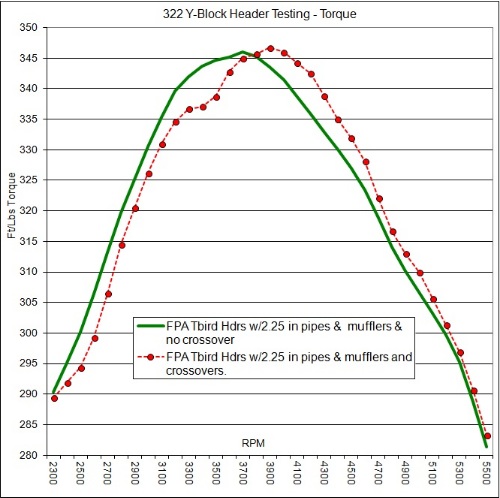 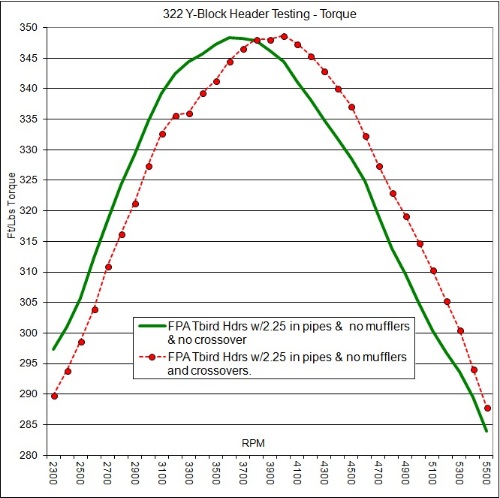 . 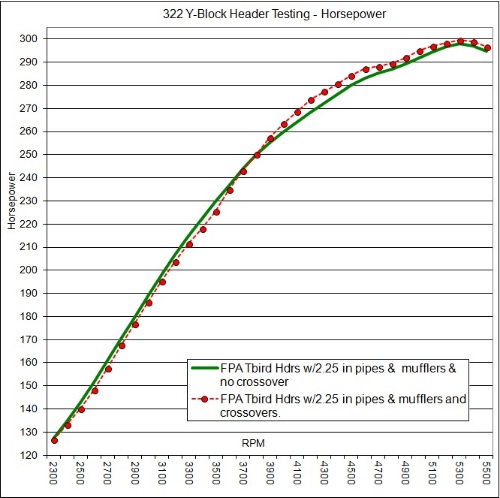 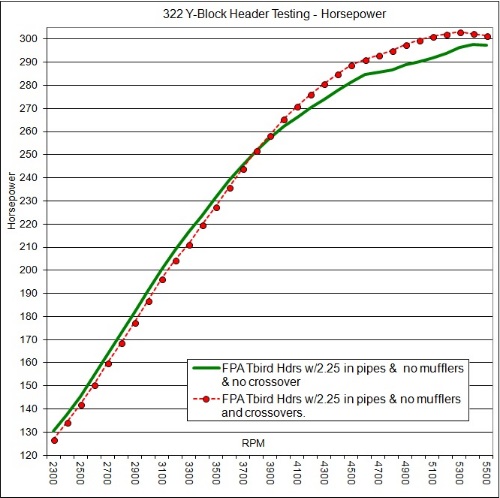
|
|
By Macs1964F100 - 13 Years Ago
|
|
Thank you for the information and all of your contributions to the Y Block commiunity. I look forward to reading your post whenever I log on. My quest is for power in the 1000-3000 range and it looks like the cross over is shifting power ever so slightly upward. A good mellow sound is also good so I will start with the ram horns go from there. I am considering a "h" configuration for the exhaust with the tail pipe exiting behind the passenger rear tire. Do you have any recomendations on pipe sizing for an engine that will never turn more than 3500?
|
|
By LordMrFord - 13 Years Ago
|
|
Ted (10/7/2013)
My own experience with crossover pipes on daily drivers is that they do mellow out the exhaust notes on a V8 and stop some of the ‘popping’ noises that can occur out of the end of the pipes while cruising.
True.
I like more my non-crossover Y-Block sounds in Fairlane than the sounds of injection era Mustang with crossover. You can hear Y-BLock beat in stereo while standing behind the car.
|
|
By Ted - 13 Years Ago
|
|
Macs1964F100 (10/12/2013)
...... Do you have any recomendations on pipe sizing for an engine that will never turn more than 3500? While a normal thought process might indicate that the smaller sized pipes would enhance lowend torque production, dyno testing that was performed on a Y engine with the different sized pipes indicates otherwise. Here are the graphs showing HP & TQ attributes with the different sized tail pipes installed on the 322” dyno mule. . 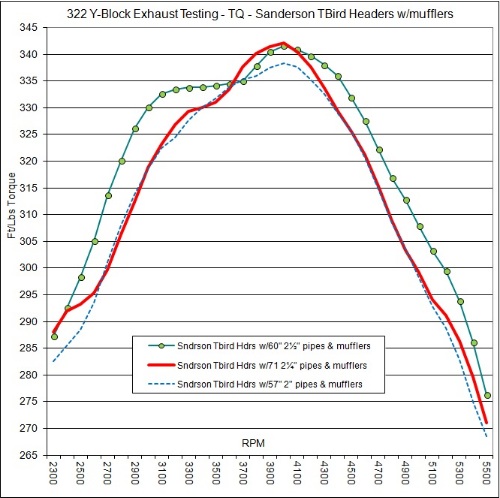 
|
|
By yalincoln - 13 Years Ago
|
|
damn! what she said, bigger is better!!! say ted, did you ever test those big tube headers on anything?
|
|
By Macs1964F100 - 13 Years Ago
|
Thank you again Ted. I will go with Ram Horns and 2 1/2 pipes necked in the way you did for the test. Work is slowing down and the weather is cooing off so I am ready to spend some time on the old truck.
By the way, the is Mac just North of San Antonio. I will stop by and thank you in person next time I am up your way.
|
|
By Ted - 13 Years Ago
|
|
A comment came up in another thread suggesting that the single exhaust crossover pipe system actually made better low-end torque than duals. Data from dyno testing does suggest otherwise. Here’s the graph displaying the torque values for the factory dual exhaust manifolds versus the single exhaust crossover system. 
|
|
By ejstith - 13 Years Ago
|
I am sort of surprised that as good '57 stock manifolds are they haven't been reproduced into steel headers. Seems like someone with a tubing bender, electric hack saw & great welding ability would have done this. With the cost of swap meet & ebay manifolds being what they are I'd think they'd sell like hotcakes if they were in the $200-$250 range.
|
|
By Ted - 13 Years Ago
|
|
ejstith (12/8/2013)
I am sort of surprised that as good '57 stock manifolds are they haven't been reproduced into steel headers. Seems like someone with a tubing bender, electric hack saw & great welding ability would have done this. With the cost of swap meet & ebay manifolds being what they are I'd think they'd sell like hotcakes if they were in the $200-$250 range.
Reds makes two different sets of headers for the ’54-’56 cars. The one tube variety is listed at $220 while the two tube variety is listed at $295.
Here’s the link to a chart comparing some of the various exhaust manifolds and tubing headers. The headers that are simply a bolt-in replacement for the cast iron dual exhaust manifolds do not typically give much if any power boost over the cast iron exhaust manifolds.
http://forums.y-blocksforever.com/FindPost58704.aspx
|
|
By ejstith - 13 Years Ago
|
|
Ted, you mentioned, in the test, Fenton cast iron manifolds. What is the deal on those? I assume they are rare as hen's teeth..
|
|
By Ted - 13 Years Ago
|
|
ejstith (12/19/2013)
Ted, you mentioned, in the test, Fenton cast iron manifolds. What is the deal on those? I assume they are rare as hen's teeth.. The Fenton manifolds have not been available for a good number of years now. There was a move recently to have them cast overseas but still waiting to hear more about that. For now, the manifolds seem to be relegated to ‘collector’ status as those people that have them, seem to have more than one set.
|
|
By vntgtrk - 13 Years Ago
|
I'll admit I chose the aftermarket ram horns for my truck after seeing how they stacked up to the other configurations. While I don't have the induction or head mods, they will be a good choice for a street truck being built to haul a 2500 lb trailer on a regular basis. I looks I'll be making up an exhaust using mostly Hearthrob bits.
And yes I agree that this is valuable info. Heck this whole site has steered this novice in the right direction
|
|
By CK and his 55Tbird - 12 Years Ago
|
Ted,
Have you or will you be testing Mummerts T-Bird headers?
Do you have any expectations of what results may occur?
Chris
|
|
By Ted - 12 Years Ago
|
|
CK and his 55Tbird (1/26/2014)
Ted, Have you or will you be testing Mummerts T-Bird headers? Do you have any expectations of what results may occur? ChrisWhile I haven’t specifically tested a set of headers that came directly from John, there’s a chance they have been already tested depending upon who his supplier is. Here’s a couple of links showing pictures of some of the various headers and exhausts that have been tested thus far which can be used to compare some of the various designs against each other.
.
http://forums.y-blocksforever.com/Topic55379.aspx?PageIndex=3 . http://forums.y-blocksforever.com/FindPost55795.aspx . And here is the chart again showing the ‘best’ score for each exhaust system tested thus far. Keep in mind that the best score does not necessarily produce the best peak horsepower or peak torque values. | Description. | Score | Peak HP | Peak TQ | Avg HP | Avg TQ | Mufflers | Testing configs | | Single exhaust with crossover pipe | 1484 | 239 | 303 | 202 | 276 | NO | 2 | | 1955/56 Dual Exhaust manifolds | 1629 | 274 | 327 | 223 | 301 | NO | 4 | | Reds/Hedman two tube headers | 1635 | 278 | 327 | 224 | 302 | NO | 3 | | 1957 Dual Exhaust manifolds | 1650 | 279 | 330 | 226 | 305 | NO | 4 | | Fenton cast iron manifolds | 1663 | 282 | 332 | 228 | 308 | NO | 2 | | Tri-Y stepped shorty Tbird headers non-firing order specific - GB | 1675 | 294 | 332 | 230 | 309 | NO | 4 | | Ram Horns w/2”into 2¼” pipes | 1683 | 283 | 337 | 230 | 312 | NO | 2 | | Shorty 1.625” w/box collectors - DC | 1693 | 284 | 336 | 231 | 314 | NO | 1 | | JC 4 tube car chassis shorty headers | 1739 | 296 | 347 | 238 | 322 | NO | 6 | | Tri-Y pickup headers firing order specific-CC | 1739 | 297 | 347 | 238 | 322 | NO | 5 | | Sanderson 1½” T-Bird headers w/2½” pipes | 1751 | 297 | 350 | 240 | 324 | NO | 11 | | Sanderson 1½” Pickup headers w/2½” pipes | 1751 | 300 | 350 | 240 | 324 | NO | 5 | | Reds 1.625” 4 tube hdrs for 55/56 car | 1753 | 295 | 347 | 240 | 325 | NO | 8 | | Fenderwell headers 1.75” tubes - MW | 1768 | 306 | 344 | 242 | 327 | NO | 5 | | Fenderwell headers 1.625” tubes | 1769 | 308 | 346 | 243 | 327 | NO | 5 | | KC 4 tube Maxton Mile 1 5/8” headers | 1775 | 310 | 351 | 244 | 328 | NO | 4 | | Rdstr 4 tube 1.75” gattling collector hdr | 1778 | 309 | 355 | 244 | 329 | NO | 2 | | EMC headers 1.75”/1.875” stepped | 1780 | 310 | 349 | 244 | 329 | YES | 4 | | FPA T-Bird hdrs 1.625”/1.75” stepped | 1780 | 311 | 342 | 244 | 329 | NO | 13 |
|
|
By CK and his 55Tbird - 12 Years Ago
|
Thanks Ted. The FPA type are the ones I was thinking of.
I think I'll go for the Saunders shorty that I saw on Ebay for $250.
Due to I will be using the car as a daily driver and from what you were saying about coated heaaders, stainless is a much better choice, and its only 10HP.
I'll spend the extra on the intake.
|
|
By ian57tbird - 12 Years Ago
|
|
It would be interesting to hear what you think of the quality and fit when you get them.
|
|
By Ted - 5 Years Ago
|
The exhaust testing results were published in the Nov-Dec 2020 issue of The Y-Block Magazine. There were some additional tests in that article that were not published in this particular thread. Because this thread was quite old, the pictures of the various exhausts did not transfer when the website changed servers. The article as it was published in the YBM has been made available on the Eaton Balancing website. Those missing pictures are now in the Eaton Balancing article. Here’s the link.
Y-Block Exhaust Testing
|